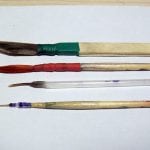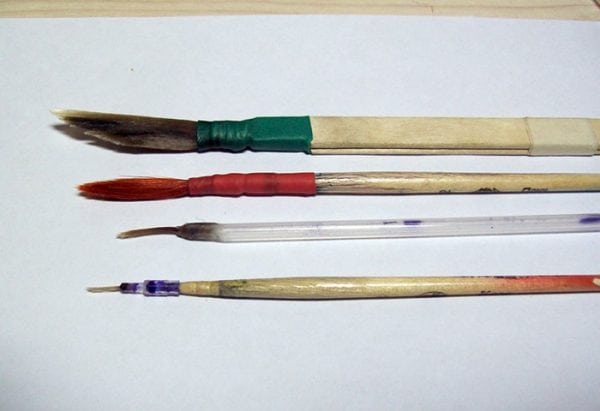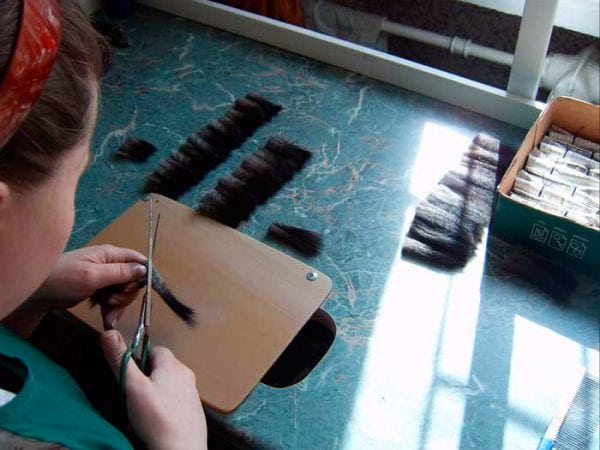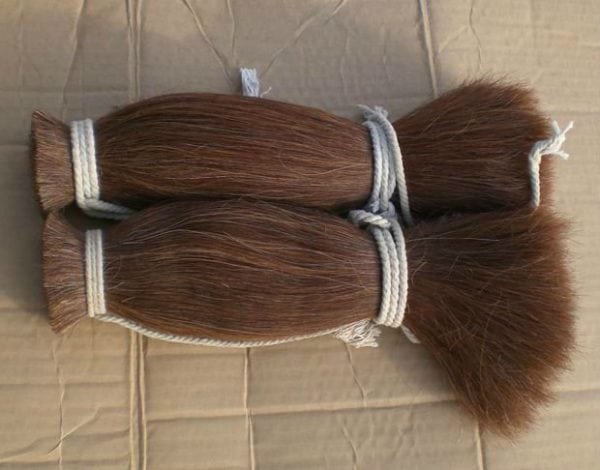In modern conditions, the manufacture of a brush with their own hands is usually carried out using bristles and animal hair. You can make such brushes with your own hands and get a quality tool for painting or painting. Depending on the scope of use, brushes can be made round or flat. In addition, the pile may be shortened or elongated.
- Manufacturing technology
- Material selection
- Hair blank
- Knitting brush
- Pen making
- Pile length selection
- Conclusion


The most common and high-quality are the brushes from the hair of the tail of such animals:
- badger;
- column;
- proteins;
- gerbils.
Given the high cost of tools from animal hair, which were listed above, in homemade brushes this material can be replaced with wool and hair of other animals. In particular, recently tools from mink, fox and fox wool are more and more common. In addition, waste from the activities of fur factories can be used as material. Also, the pile can be made from the wool of camels, sheep or long-haired dogs, as well as from human hair.
to contents ↑Manufacturing technology
The first step in the manufacture is the preparation of bristles or animal hair. In addition, a brush stand and grip material should be prepared. However, first of all, you should start with the choice of material for the bristle bundle.
Material selection
When choosing a material, you need to focus on what kind of work you plan to use the brush on. So, for painting with watercolors or oil, some materials are suitable, and for delicate painting works - others. However, there are areas of use that require the use of certain material. For example, for ink drawing, most masters prefer to use camel wool products.

Consider the main characteristics of the most common homemade brushes, depending on the material used:
- Gerbil brushes, as a rule, are made flat with a long or short hair surface. They are distinguished by soft and supple hair. Therefore, such tools are mainly used for fine painting or painting with oil paints or watercolors. In addition, brushes with gerbil nap can be used for glaze varnish coating.
- Badger products are round or flat in shape. They are somewhat tougher than the previous version, and therefore they are mainly used for work with oil paints.
- Brushes having a column pile can be flat and round. They have high elasticity and resilience. They are mainly used to perform delicate work, as well as for raw glaze.
- Squirrel brushes can only be round. They are exceptionally soft and flexible, so they are mainly used for painting on porcelain or paper.
Hair blank
It is advisable to start harvesting in early autumn, when the animals molt. Separate unsuitable hairs are removed from the collected bundle and trimmed. Next, the trimmed part is placed in a glass for alignment. The hair bundle obtained after this should be combed out using a comb with sharp teeth.
Carefully combed pile should be bandaged and degreased in clean gasoline. To do this, the bundle is stored in a closed jar for several days, after which it is boiled in a tanning solution to make the hairs non-hygroscopic.

The next step is hardening, the conditions of which depend on the type of hair. Usually the hair is kept at a temperature of 150 degrees for about an hour. For hardening, the beam is placed on a metal mesh or suspended so that the hairs are well warmed up with air of the required temperature.
to contents ↑Knitting brush
A pile that has been hardened is suitable for knitting a brush. For this, a certain number of hairs is taken and lowered into a tin or plastic form with a conical bottom. This form must be prepared in advance. After you put in the mold the necessary number of hairs, you can make a blank for the brush by tapping on this shape. Next, the hair bundle is removed and bandaged, after which the non-working surface is varnished. It is inserted into a metal capsule or clip.
The capsule can be made either from thin metal strips, connecting their edges with an overlap with soldering. In addition, this can be seamless, which is considered a more acceptable option.
It is recommended to make a capsule of brass or tinplate, as these materials are durable and corrosion resistant. Its size will depend on the desired brush number. Also at this stage, do not forget about such an important element as a stand for brushes.

Pen making
After you have managed to make a pile, you should start making pens. It is best to carve out of such tree species:
- Pine;
- beech;
- alder;
- Birch.
After turning the handle is coated with colorless varnish or painted with a solid color paint. Next, the bundle inserted into the capsule is poured from the wide end with synthetic glue or other waterproof composition. This must be done so that the glue reaches the end of the pile, which is in the capsule.
After everything has dried, the capsule with a bunch of bristles should be connected to a wooden handle. For durability it is recommended to squeeze an additional capsule with a wooden handle. The finished handle should be varnished.
to contents ↑
Pile length selection
You need to choose the length of the bristles released from the capsule. The length of the released hair should depend on its elasticity. This is of fundamental importance, because if you release the bristles too long, the brush will look disheveled. Otherwise, a loose pile will not draw in enough paint.
to contents ↑After you have decided on the length, the finished brush must be moistened with water and combed until the bristles become as even as possible.
Conclusion
Thus, making a brush with your own hands is a completely affordable procedure. It consists of several stages, one of which is the choice of material. Hair and bristles are selected in this case, taking into account the purpose of the brush and financial capabilities.




